Why are Raspberry Pi prices so high? Will it improve?

Raspberry Pi CEO Eben Upton has released some good news about supply gradually returning to normal levels in 2023.
That’s good news for all of us because Raspberry Pi enthusiasts have paid inflated prices for Raspberry Pis for a long time.
Pandemic prices of the Raspberry Pi
Let’s look at the prices of various Raspberry Pi computers over the pandemic thanks to data from Keepa, which tracks prices on Amazon.
2GB Raspberry Pi 4
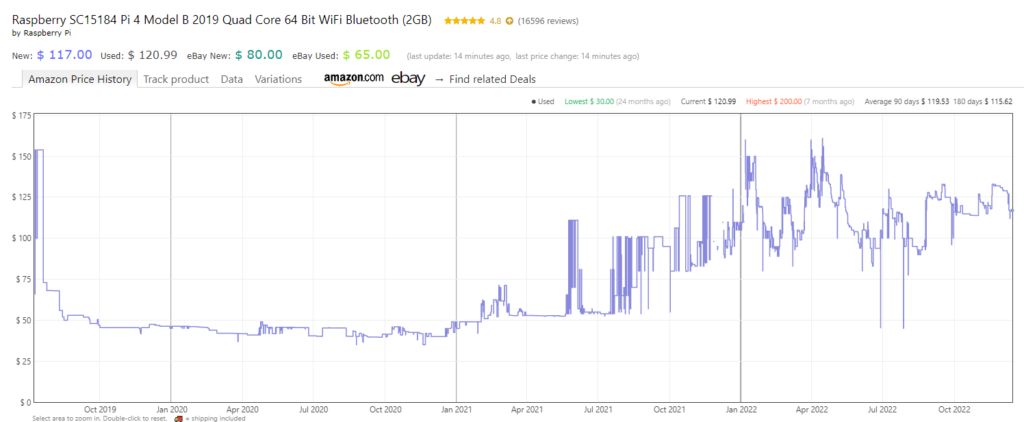
Statistics

4GB Raspberry Pi 4
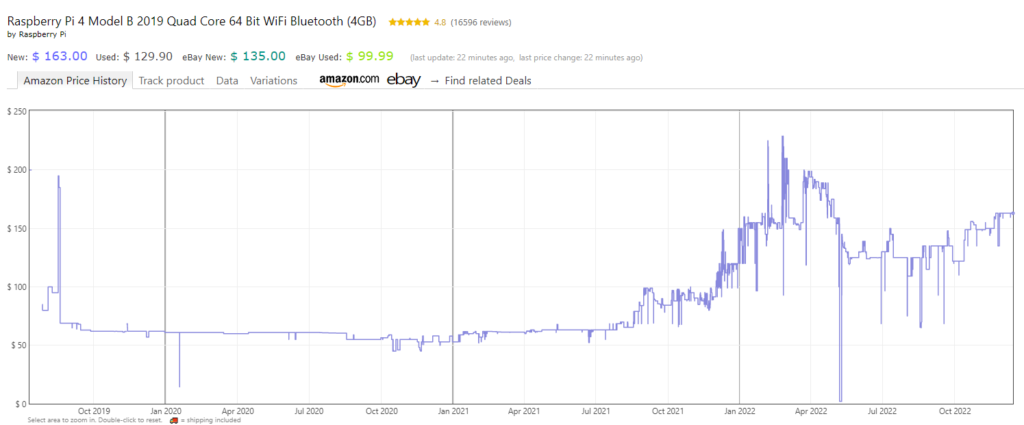
Statistics

8GB Raspberry Pi (announced May 2020)
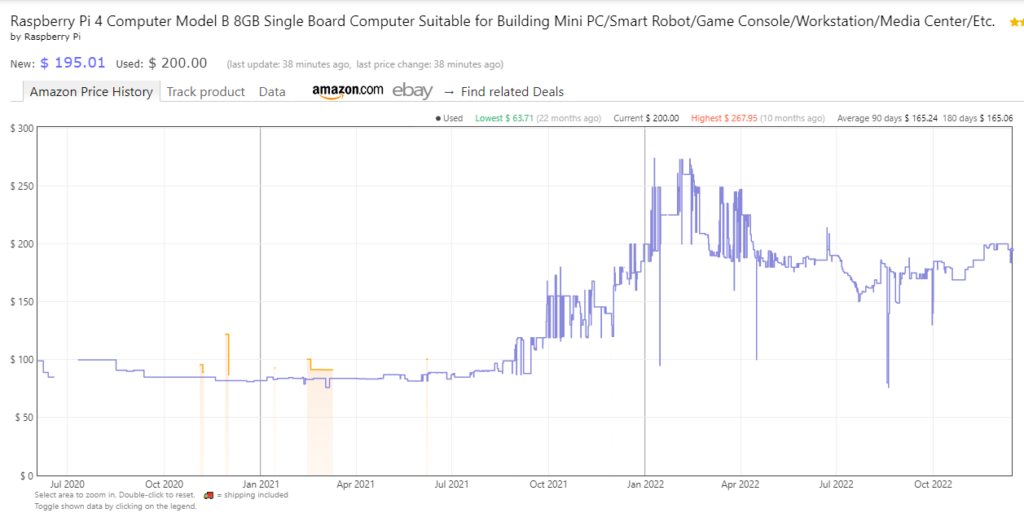
Statistics

Raspberry Pi Zero 2 W (released Oct 2021)
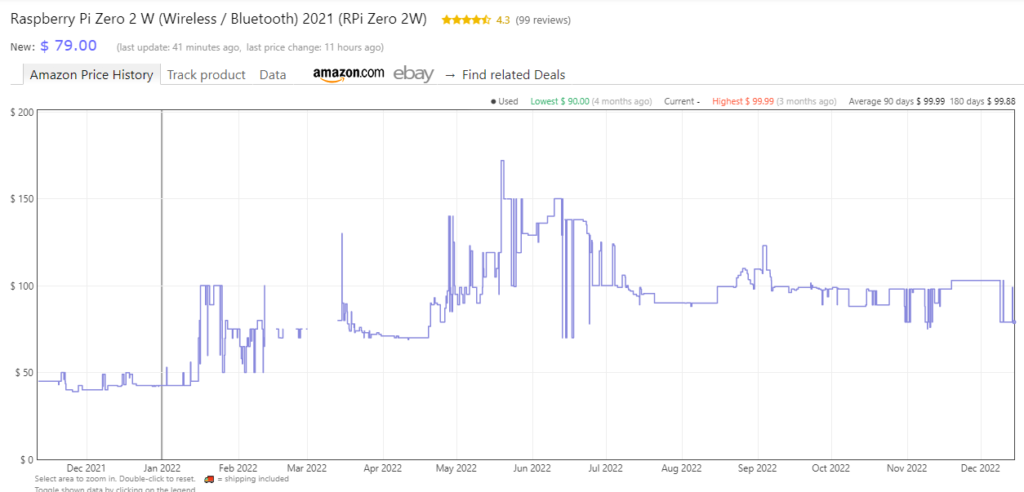
Statistics

Raspberry Pi Zero W
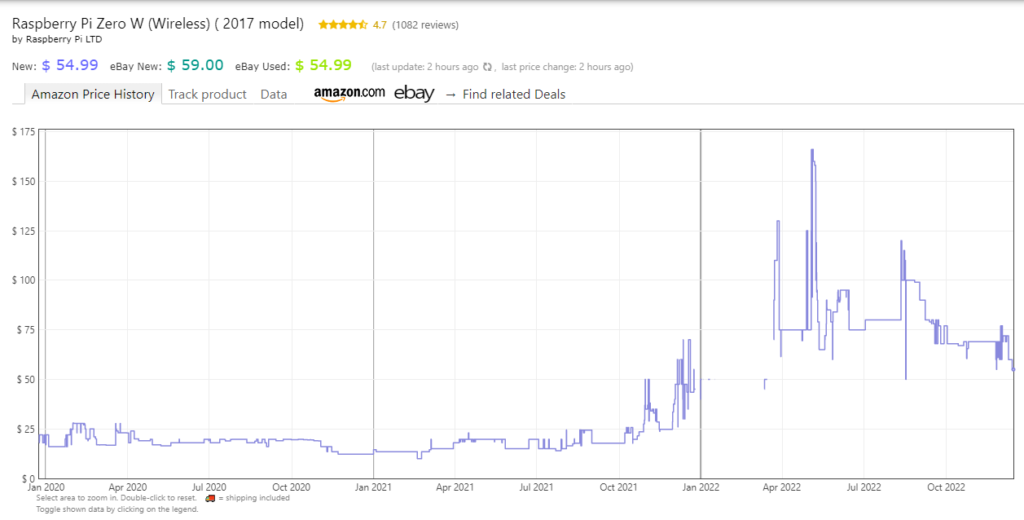

Recommended retail prices vs peak prices
Using data from Keepa, and comparing the official US dollar prices from Adafruit, you can see that there’s a major difference between recommended retail price (RRP) and the peak price.
While the price inflation of the Raspberry Pi 4s seem to hover around 4 times, the Pi Zero series’ prices are inflated by over 10x.
| Board | RRP (USD) | Peak price | Multiplier |
| 2GB Raspberry Pi 4 | 45 | 161 | 3.58 |
| 4GB Raspberry Pi 4 | 55 | 229 | 4.16 |
| 8GB Raspberry Pi 4 | 75 | 274 | 3.65 |
| Raspberry Pi Zero 2 W | 15 | 172 | 11.47 |
| Raspberry Pi Zero W | 10* | 166 | 16.6 |
Why did Raspberry Pi prices skyrocket?
Eben Upton explained it succinctly in his Dec. 18, 2022 interview with Christopher Barnatt’s YouTube channel, Explaining Computers.
Upton said this, “I guess we’re 18 months now into what I would be consider to be constrained availability of Raspberry Pi.”
Eighteen months from December 2022 is summer 2021. It started with sporadic shortages that got severe by late 2021.
Global semiconductor shortage affected Raspberry Pi prices
Upton stated that at the start of the pandemic in 2020, people assumed a large recession was coming.
There wasn’t any recession in the early pandemic beyond a little blip.
But companies stopped ordering as they tried to sell off their inventory in view of this prediction.
But people couldn’t do much with their money. No travel, no dining out. In fact, no point going out because most people worked from home.
Where did people start spending their money? Goods, particularly electronics.
Well, demand for the Raspberry Pi also rose through the pandemic. Raspberry Pi CEO Eben Upton mentioned that they would have sold much more if not for the supply constraints.
“We sold 7 million Raspberry Pis in 2020, which was a strange year but obviously an unconstrained year. Last year we were constrained by chip supply — sold 7 million again, in an environment where I’d expect to sell 8 or 9, maybe 9 or 10. This year we’ll be down. We’ll be fewer than 7 million,” he said on the Cambridge Tech Podcast in 2022.
Oops! Raspberry Pi couldn’t turn back the clock to get back the unused manufacturing capacity of 2020. Plus, semiconductor manufacturers didn’t have much spare output that could handle the demand shock.
Upton pointed to toilet paper and hand sanitizer being examples of how hoarding behaviour worsened as people saw others buying in excess.
Scalpers skyrocket Raspberry Pi prices
Seeing an opportunity here, scalpers entered the market and bought Raspberry Pi computers at official prices and flipped them on other marketplaces for multiple times their value.
If you wanted to buy a Raspberry Pi microcomputer and get it as soon as possible, you would have to buy it from a scalper at an inflated price, unfortunately.
Your next best alternative is to use certain resources to buy the board including rpilocator, our Reservation Tool or by going to the Raspberry Pi official store in Cambridge.
All of these alternative options are generally less attractive than clicking and buying online.
In response, Approved Resellers such as buyzero.de have implemented anti-scalping policies and quantity limits.
Raspberry Pi also took action to ensure that stock that goes to industrial customers do not end up on the secondary market at scalped prices. This is according to Jeff Geerling’s chat with Eben Upton, in which Upton says “[Raspberry Pi has] set up a new process to ensure the OEM’s they’re supplying aren’t scalping the boards”
Will Raspberry Pi prices fall when availability improves?
Yes, prices are likely to fall precipitously once supply returns.
But here’s a caveat: Raspberry Pi has increased some prices on some boards in the past year so those will likely serve as price floors.
For example, Raspberry Pi announced that they’re moving the price of the Raspberry Pi Zero up by $5. So a Zero would cost $10 and a Zero W would cost $15.
The 2GB Raspberry Pi 4 also took a $10 price increase in late 2021 to $45 and brought the Raspberry Pi 4 1GB back from the archive, at a $35 price point.
Upton also warned that the Pi Zero 2 W’s price point, which will still remain at $15 as of December 2022, has the potential to increase in price. He mentioned that profit margins are thin at this price point as prices of components have increased.
When can we expect prices of Raspberry Pis to fall?
A bit of crystal balling here, so none of these might end up accurate down the road.
However, Raspberry Pi feels positive that 2023 will see the end of supply problems.
A generally improving 2023 price and supply picture
Just before Christmas 2022, Raspberry Pi CEO Eben Upton mentioned that he expects 2023 to see a marked change in supply.
If a constrained supply led to the spike in prices, thanks to scalpers, then the less constrained the supply of Raspberry Pis, the more prices will fall.
“For the first time in a couple of years of semiconductor supply chain hell, we’ve got some good news for you,” he said. “We can say with confidence that, after a lean first quarter, we expect supply to recover to pre-pandemic levels in the second quarter of 2023, and to be unlimited in the second half of the year.”
Based on Upton’s quote, you can predict that the first quarter of 2023 will see minimal shifts in prices. The gap between the official prices and the scalper’s prices will still be large.
The best takeaway here is that the second half of the year will see “unlimited” supply of Raspberry Pis. Theoretically that means that prices should fall back to pre-pandemic levels.
Expect a staggered reduction in prices?
Raspberry Pi also revealed that different models will experience different changes.
“As we go through the year, it is likely that you’ll see Zero and Zero W come back into general availability first, followed by products like Raspberry Pi 3A+ which do not have an extensive industrial customer base; and, finally, the various versions of Raspberry Pi 4,” Upton said.
According to this, the Zero and Zero W boards will likely see prices fall because their supply would increase first. As the year goes on, the 3A+ and the Pi 4 would see similar changes in prices.
However, the price inflation of the Zero boards are the highest, at 16.6 times, comparing official prices to peak Amazon new prices. The hazy part here is how far the prices of the Zero boards will fall.
If you’re looking for an industrial Raspberry Pi, expect the worst
If you re-read the quote by Upton above, he mentioned that products “which do not have an extensive industrial customer base” are likely to see an increase in supply sometime in 2023.
Why did Upton specifically mention products without an “extensive industrial customer base”?
It turns out that products with an industrial use case are generally bought by bots in bulk.
“I think single-unit supply of CM3/3+ is likely to be one of the later things to recover, perhaps in late Q2 or early Q3. For products like this, with a significant industrial customer base, it’s very hard to stop them getting hoovered up into the grey market,” Upton said.
“Some 3B and 3B+ will make their way into the single-unit market over the next few months, but as I’ve said in response to other posts they’re so popular in industrial applications that it’s hard to keep them from being hoovered up by bots. Doing our best!”
The end of scalping?
If you look at the price graphs above, you’ll notice that prices on the grey market were pretty consistent until summer 2021. Then they spiked.
In October 2021, Eben Upton published the first article to address the supply shortage, and then another in April 2022 as prices spiked even more. Upton updated the community with an optimistic view of 2023 in December 2022.
“We’ve got pretty good at keeping units out of their hands (at least at scale), but I’m hoping we can stick the scalpers with lots of unwanted inventory at the point things turn around. Some losses to make up for the profits they’ve made at our expense during the shortage,” Upton said.
We have been facing higher-than-normal prices for the past 18 months, and this will likely continue until we get to a state of unlimited Raspberry Pi supply. Upton predicts this to happen on the second-half of 2023.
Right now, if you want to buy a board at the official price from an Approved Reseller, you would have to wait or get in a queue like our Reservation Tool. Or else it’s first-come-first-serve with the help of tools like rpilocator.
When unlimited supply arrives, you will be able to buy these boards much more easily. No first-come-first-serve, fewer quantity restrictions and you’ll pay prices that are closer to official prices when buying in the grey market.
Raspberry Pi and its Approved Resellers will continue to sell prices at official prices. Any variation in prices between Approved Resellers is likely due to tax, import duties and currency fluctuations.
What does 2023 look like for Raspberry Pi stock? (Non-commercial customers)
Raspberry Pi’s future according to Eben Upton
Ich weiß nicht, wie man darauf kommt, dass ein Raspberry zu teuer ist. Es ist ein leistungsstarkes System mit vielen Möglichkeiten. Meiner Meinung nach könnte so ein System noch gut 50,00 € teurer sein, ich würde es immer noch kaufen.
Besser als der wertlose Schrott aus China, wo ohnehin alles nur abgekupfert und geklaut ist.
Es werden nur Sachen in China kopiert, bei dem der Preis überzogen wurde, denn kostenlos ist auch da die Arbeitskraft nicht.